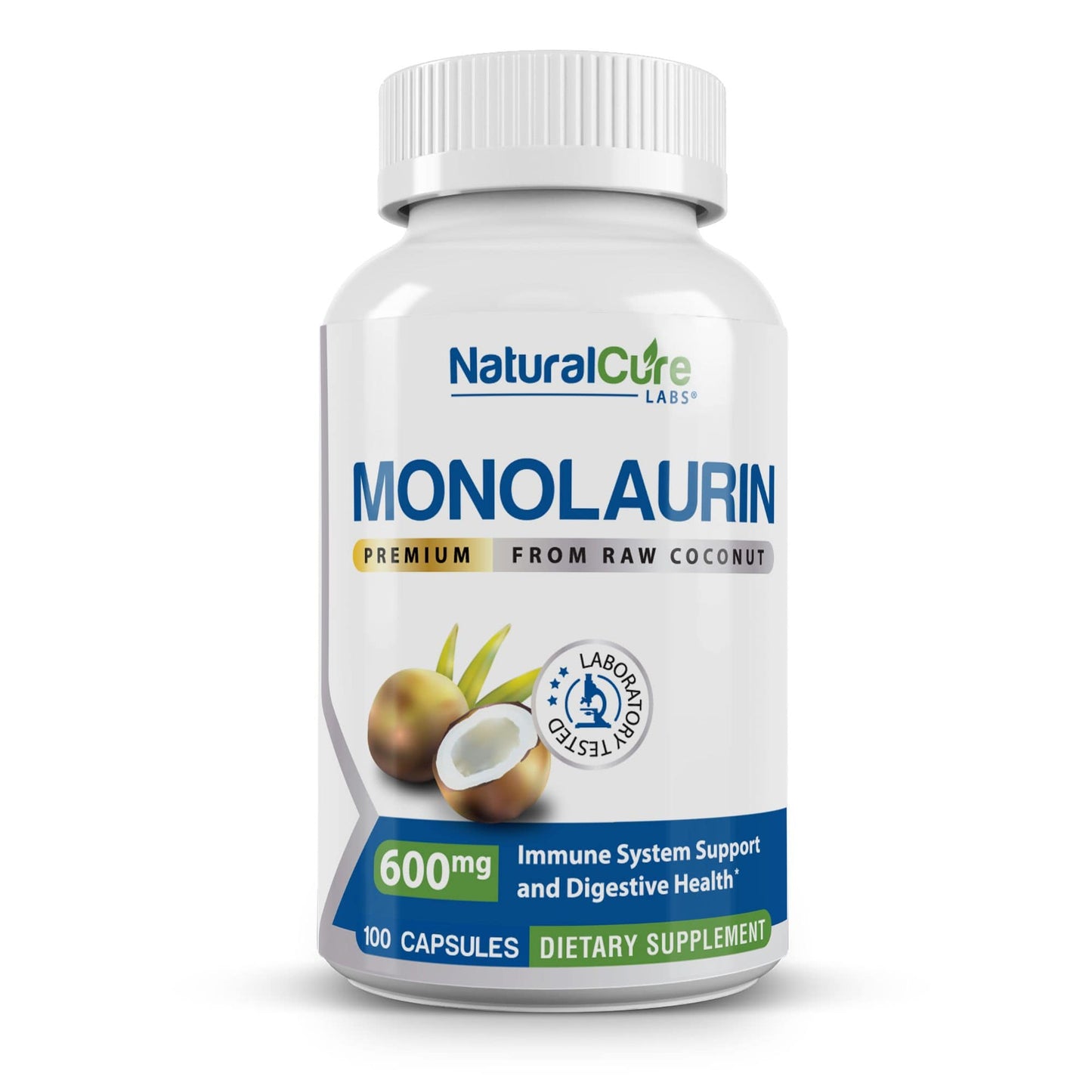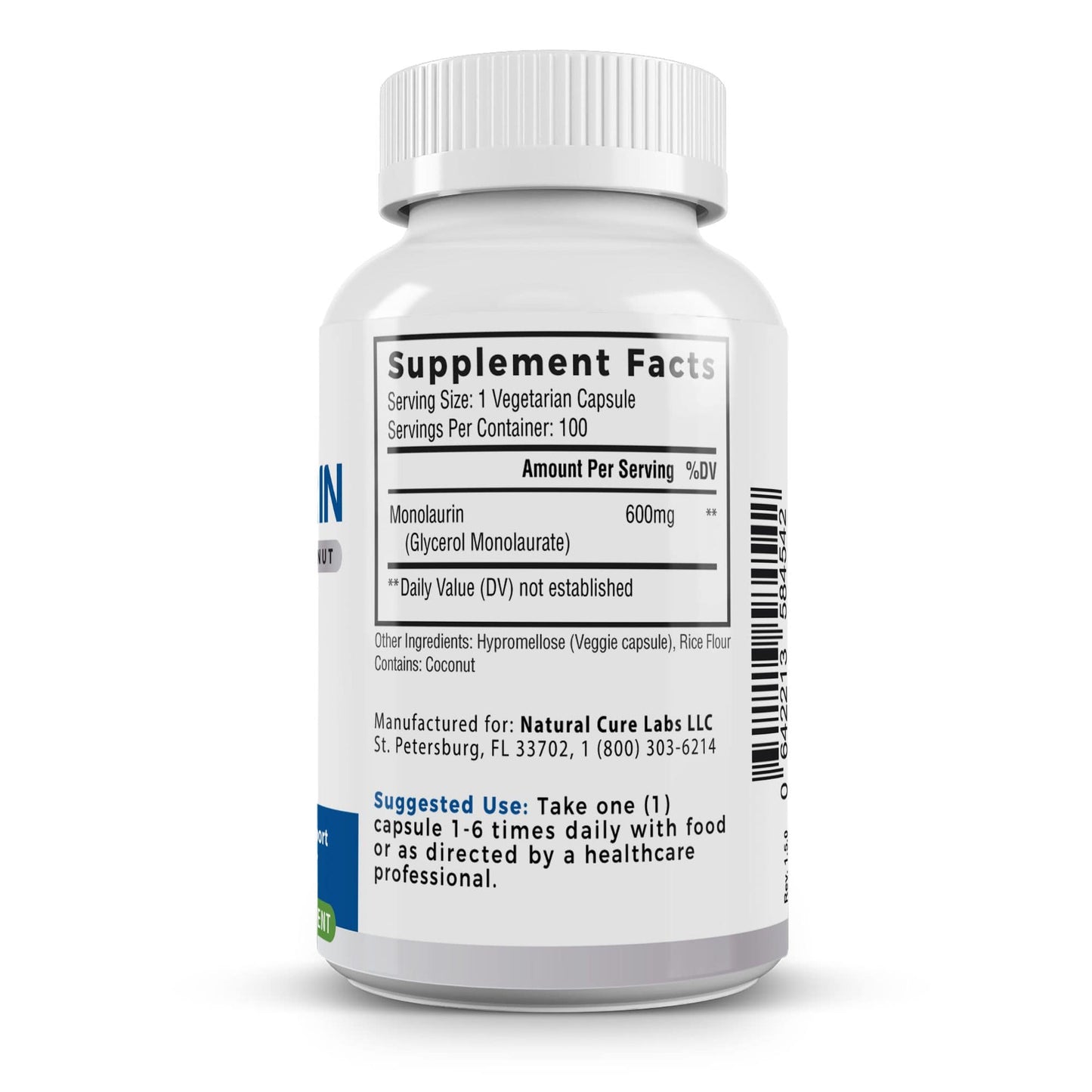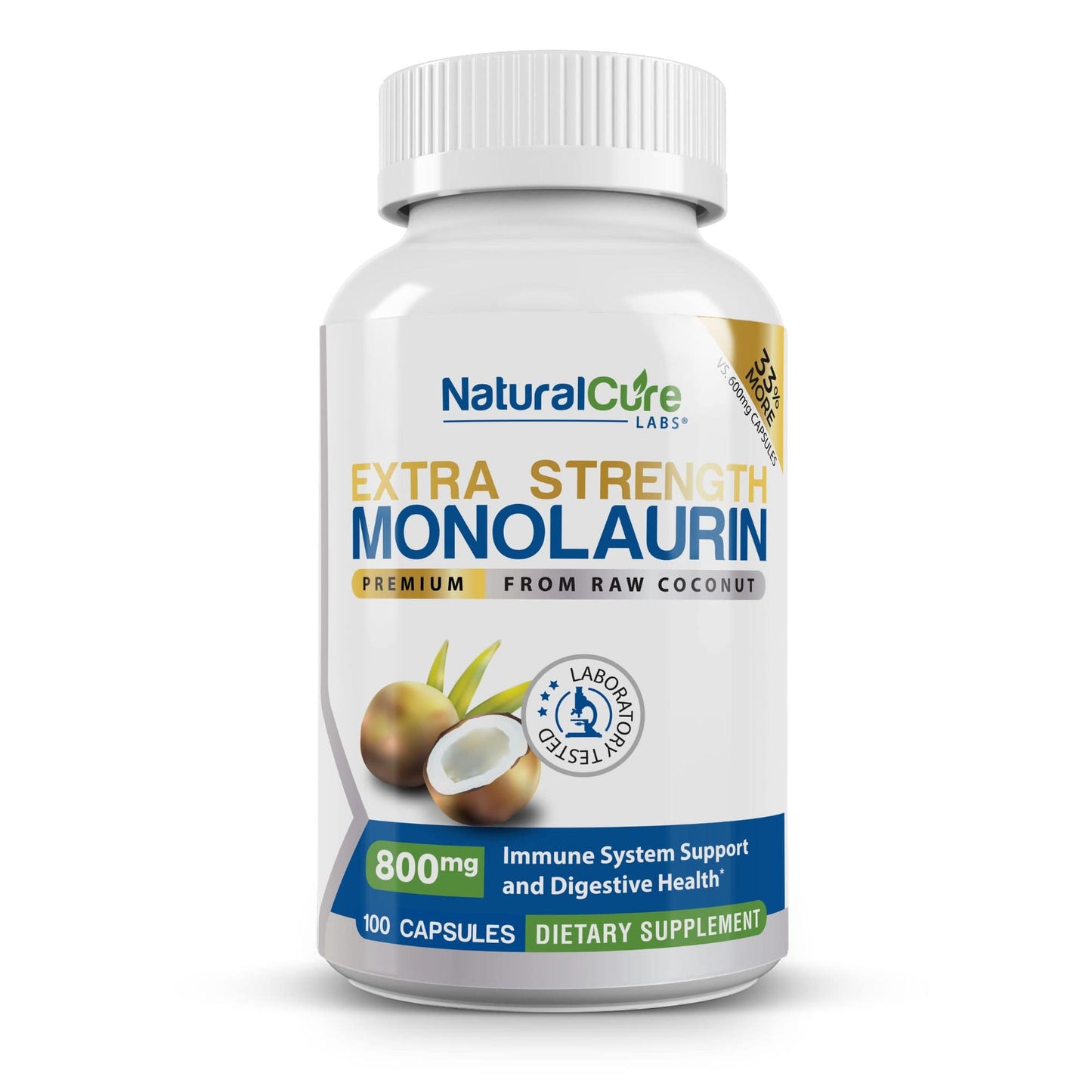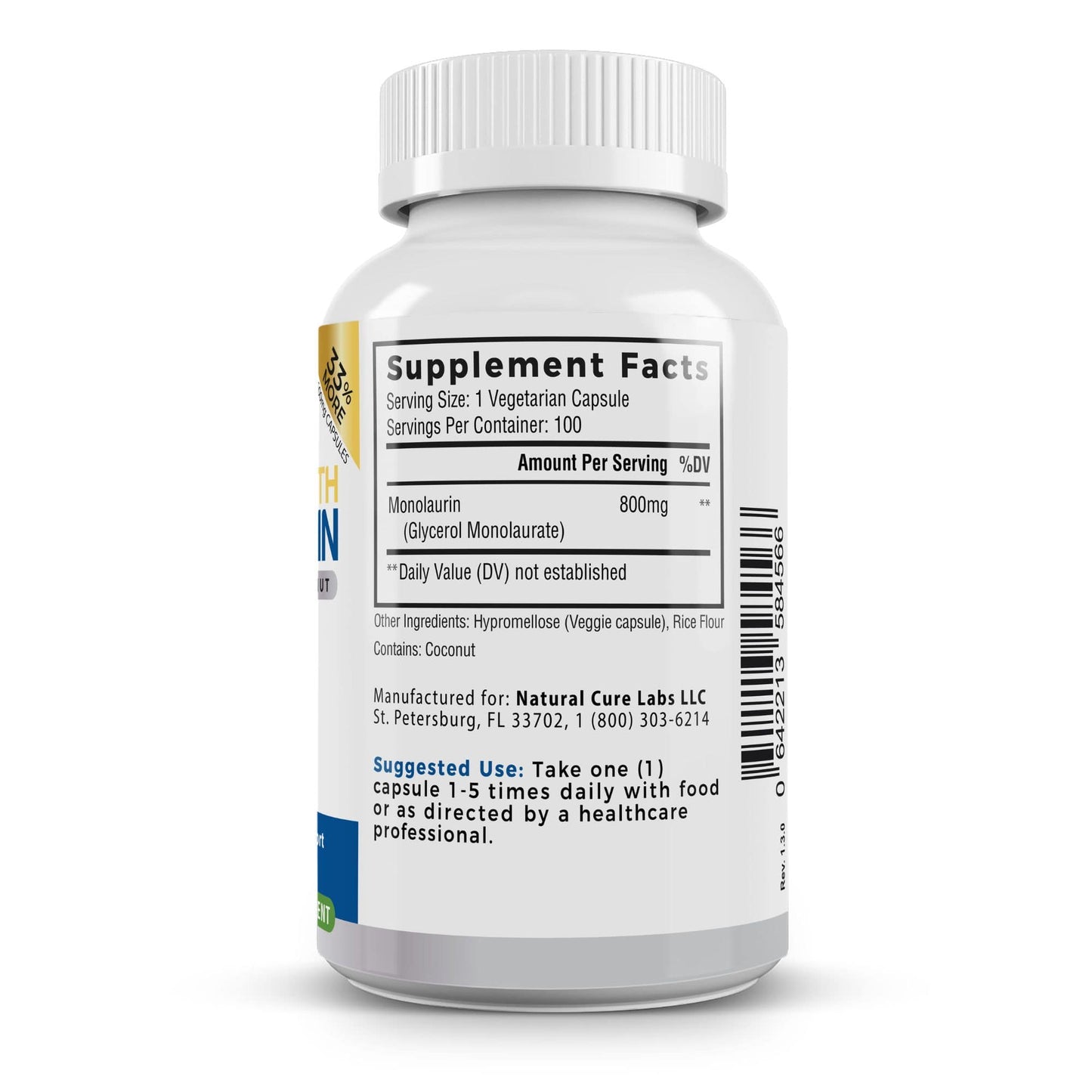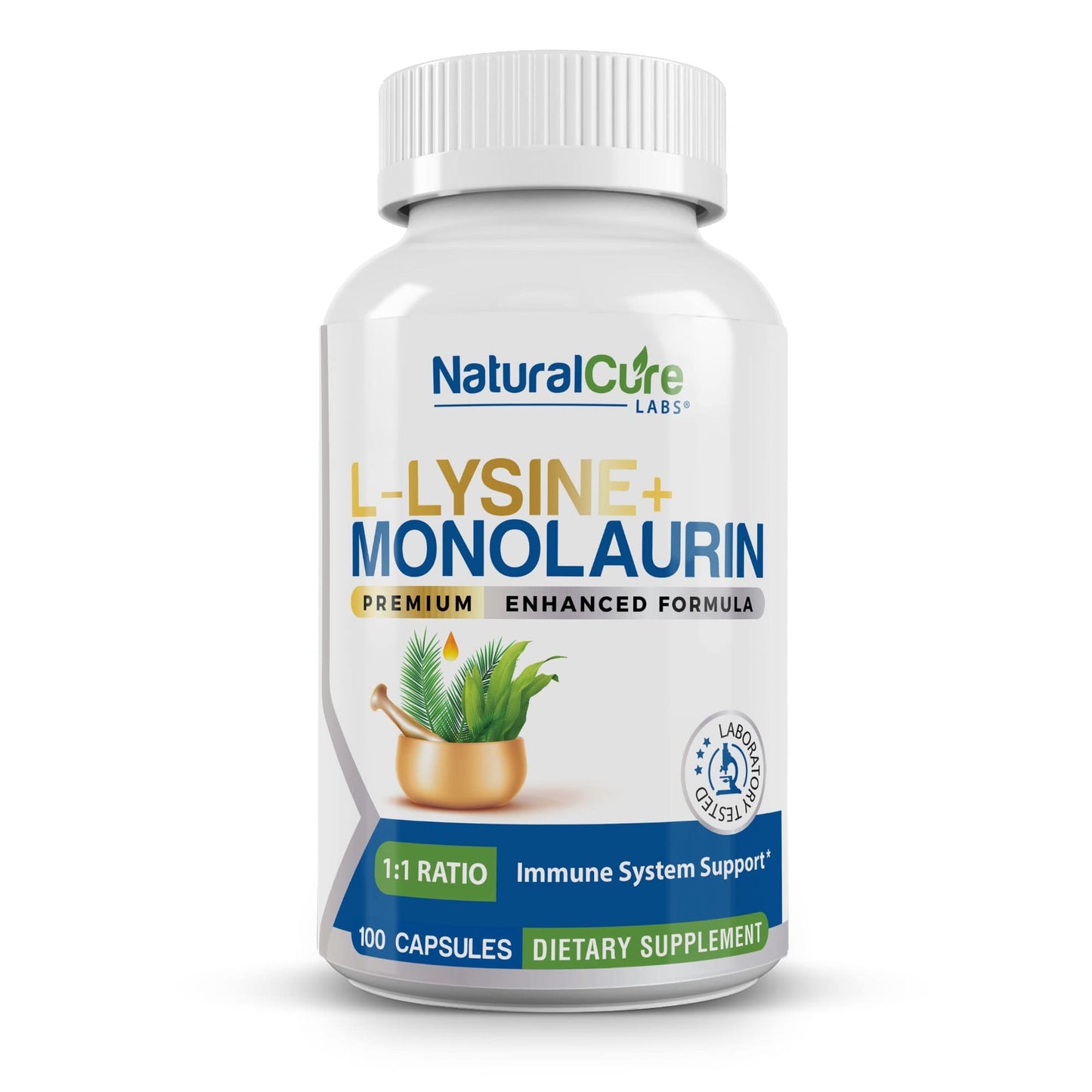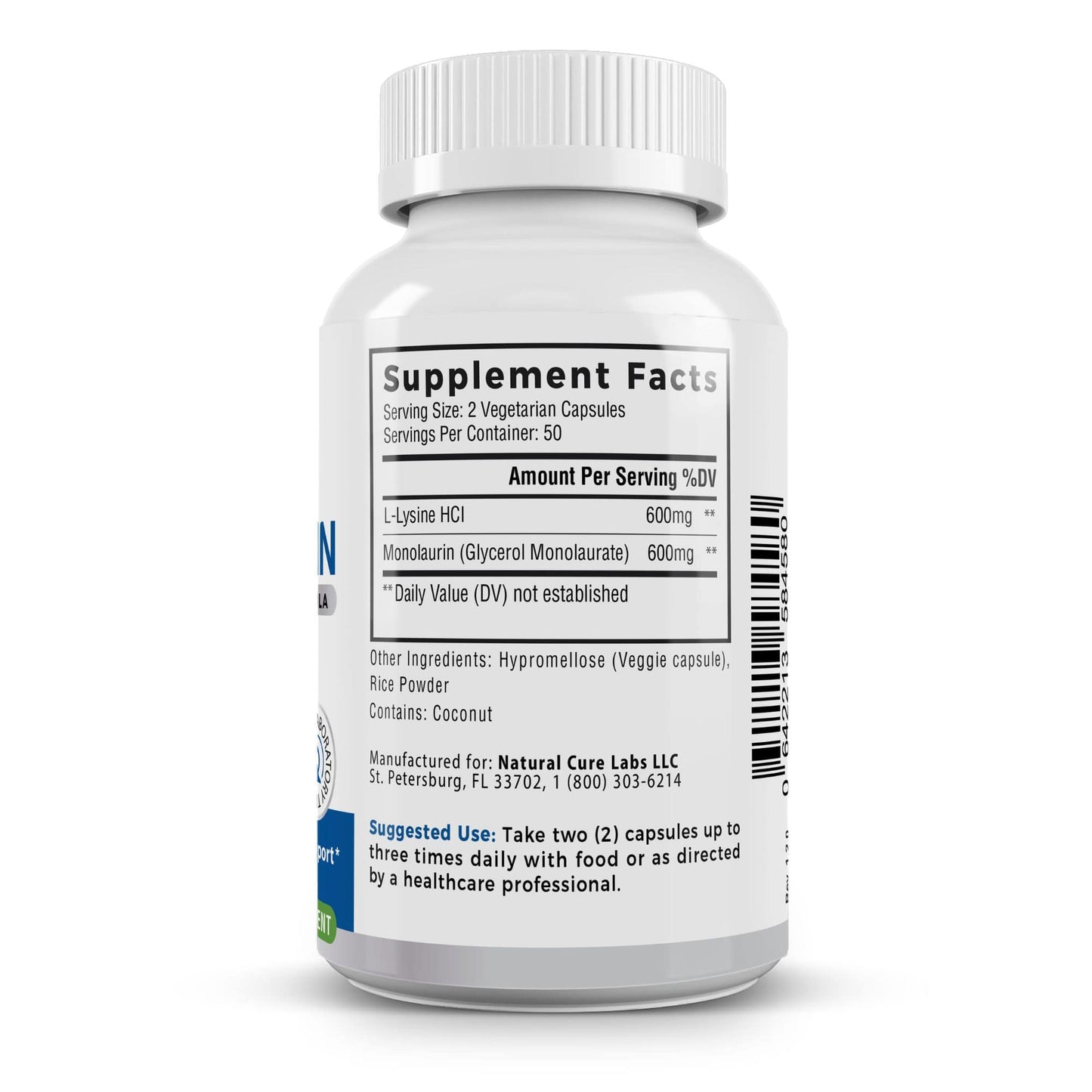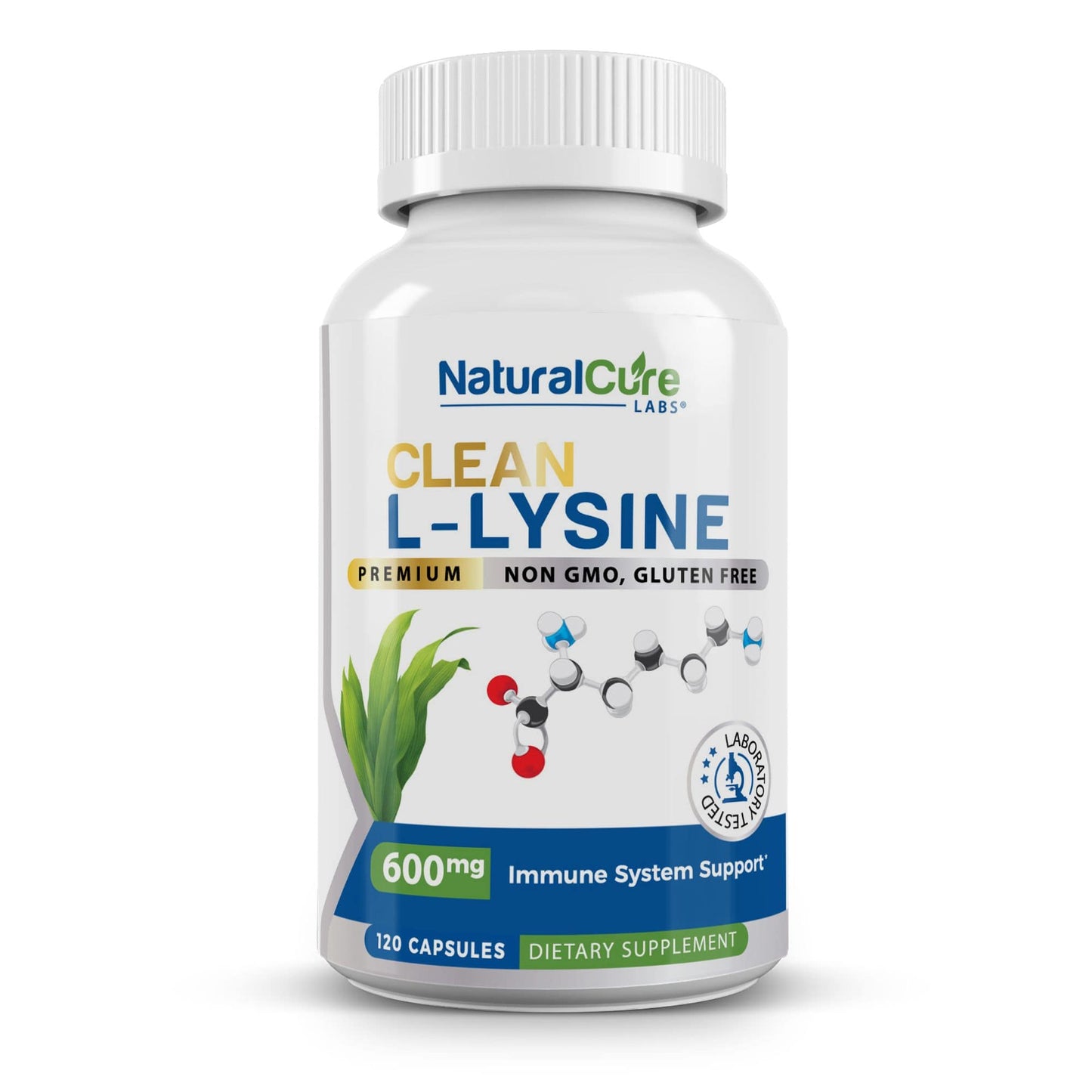
📝 Medically reviewed by Dr. Patricia Shelton
🔍 Last updated August 23, 2024
📚 21 citations
📖 5 minute read
About the Author:

Dr. Patricia Shelton, MD, has been a medical communicator and educator since 2014. She holds a Doctor of Medicine degree as well as a Bachelor's degree in Neuroscience, both from the University of Washington in Seattle.
–
While these two compounds share a close relationship and each provides distinct benefits, it’s important to know their differences—especially given their common presence in sources like coconut oil and palm kernel oil to make informed decisions about your health and wellness.
Jump To:
- What Is Lauric Acid?
- What Is Monolaurin?
- The Key Differences
- Why Consider Monolaurin?
- Final Thoughts
- References
What Is Lauric Acid?
Lauric acid is a medium-chain fatty acid (MCFA) commonly found in coconut oil, palm kernel oil, and breast milk. It makes up nearly 50% of the fatty acid content in coconut oil, making it one of the most abundant sources.‡¹ Lauric acid is known for its potential immune-supporting properties, which have been the subject of various studies.‡² However, lauric acid itself is not directly active in the body—it must first be converted into monolaurin.‡³ To learn more, you can check out the article, “Lauric Acid: Potential Health Benefits, Sources, Uses, and More.”
What Is Monolaurin?
Monolaurin, also known as glycerol monolaurate, is a monoglyceride that is derived from lauric acid. A monoglyceride is a fatty acid that has been slightly altered by being attached to a substance known as glycerol.
When lauric acid is metabolized in the body, it is converted into monolaurin.⁴ About 6.5 grams of lauric acid are required to produce 1 gram of monolaurin in the body.⁵ Because of this, it’s often difficult to get significant amounts of monolaurin from the diet. Some people choose to take supplements to ensure that they’re consistently getting enough
Monolaurin has been extensively studied for its potential to support immune health.⁶
It's believed to work by directly acting in bacteria in various ways. For example, monolaurin can disrupt the lipid membranes of microorganisms, making them more fragile and susceptible to the body’s natural defenses.‡⁷ As a result, monolaurin has become a popular supplement for those seeking to naturally support their immune system.‡⁸
See Related: How Can Monolaurin Support Skin And Hair Health?

The Key Differences
While lauric acid is the precursor to monolaurin, there are important differences between the two:
- Bioavailability: Bioavailability refers to the extent a substance is able both to be absorbed into the body and to exert its biological effects.²¹ Lauric acid must be converted into monolaurin within the body before it can exert its full effects. This conversion process is not entirely efficient, meaning that not all ingested lauric acid becomes monolaurin.⁹ On the other hand, taking monolaurin directly ensures that the body has access to this beneficial compound without relying on conversion.¹⁰
- Potency: Monolaurin is considered more potent than lauric acid in supporting immune health. It directly inhibits particular bacterial reactions, such as the synthesis of certain toxins.¹¹ While lauric acid has its own merits, research has found that monolaurin is more specifically targeted and effective in this regard.¹²
- Supplementation: Lauric acid is commonly consumed through dietary sources such as coconut oil, which also contains a mix of other medium-chain fatty acids.¹³ Monolaurin, however, is typically taken on its own as a concentrated supplement to ensure adequate intake of this specific compound.¹⁴
Why Consider Monolaurin?
For those looking to maintain their immune health, monolaurin offers a focused option. Research suggests that monolaurin may help by disrupting the lipid membranes of certain microorganisms, thereby supporting the body's natural defenses.‡¹⁵ At Natural Cure Labs, our monolaurin supplements are carefully crafted to provide quality support.‡¹⁶
While lauric acid, particularly when included in a balanced diet with sources like coconut oil, has its own merits, its direct role in immune support is different.‡¹⁷ Monolaurin, as a metabolite of lauric acid, provides a more direct way to potentially benefit from the immune-supportive properties of this compound.‡¹⁸

Final Thoughts
Understanding the difference between lauric acid and monolaurin is essential for making informed choices about your health regimen. While both compounds offer benefits, monolaurin stands out for its direct and effective support of immune health.‡¹⁹ At Natural Cure Labs, we are dedicated to providing high-quality supplements, empowering you to select the products that best support your well-being.
Explore our range of monolaurin products today to see how this powerful supplement can contribute to your overall health naturally. You might start with our Original Premium Monolaurin 600mg, or consider our Best Seller Monolaurin + L-Lysine combo product for a synergistic effect.‡²⁰
“This product is great! There are no fillers of magnesium stearate, instead only Rice Flour. It is pure and so easy to digest. Love this product and company! Recently bout several more bottles! I would highly recommend this product to family and friends! Thank you!
- Rita Falsetto (April 26, 2024)
Keep Reading: Monolaurin And L-Lysine: Better Together
----Discover how Natural Cure Labs can help you maintain optimal health with our carefully formulated supplements.
References
- Dayrit, F. M. (2014). Lauric Acid Is a Medium-Chain Fatty Acid, Coconut Oil. Journal of the American Oil Chemists' Society, 91(1), 1-10. DOI: 10.1007/s11746-013-2414-9
- Kabara, J. J., Swieczkowski, D. M., Conley, A. J., & Truant, J. P. (1972). Fatty acids and derivatives as antimicrobial agents. Antimicrobial Agents and Chemotherapy, 2(1), 23-28. DOI: 10.1128/AAC.2.1.23
- Isaacs, C. E., Litov, R. E., Thormar, H. (1995). Antimicrobial activity of lipids added to human milk, infant formula, and bovine milk. Journal of Nutrition and Biochemistry, 6(7), 362-366. DOI: 10.1016/0955-2863(95)00070-V
- Projan, S. J., & Brown-Skrobot, S. J. (1989). Monoglycerides and fatty acids are competitive inhibitors of lipoprotein lipase. Biochimica et Biophysica Acta (BBA) - Lipids and Lipid Metabolism, 1002(3), 299-306. DOI: 10.1016/0005-2760(89)90061-0
- Enig, M. G. (2006). Health and Nutritional Benefits from Coconut Oil: An Important Functional Food for the 21st Century. Indian Coconut Journal. Link
- Thormar, H., Isaacs, C. E., Brown, H. R., Barshatzky, M. R., & Pessolano, T. (1987). Inactivation of enveloped viruses and killing of cells by fatty acids and monoglycerides. Antimicrobial Agents and Chemotherapy, 31(1), 27-31. DOI: 10.1128/AAC.31.1.27
- Hilmarsson, H., Thormar, H., Kristmundsdóttir, T., Gunnarsson, E., & Þorsteinsson, Þ. (2007). The Role of Glycerol Monolaurate (GML) in the Inhibition of Bacterial Growth and the Promotion of Human Health. Journal of Biomedical Science and Engineering, 3(7), 72-77. DOI: 10.4236/jbise.2007.037001
- Batovska, D., Todorova, I., Tsvetkova, I., & Najdenski, H. (2009). Antibacterial Study of the Medium Chain Fatty Acids and Their 1-Monoglycerides: Individual Effects and Synergistic Relationships. Polish Journal of Microbiology, 58(1), 43-47. DOI: 10.33044/pjm.2009.0010
- Hornung, B., Amtmann, E., Sauer, G. (1994). Lauric acid inhibits the maturation of vesicular stomatitis virus. Journal of General Virology, 75, 353-361. DOI: 10.1099/0022-1317-75-2-353 ‡
- Isaacs, C. E., & Thormar, H. (1991). The role of milk-derived antimicrobial lipids as antiviral and antibacterial agents. Advances in Experimental Medicine and Biology, 310, 159-165. DOI: 10.1007/978-1-4615-4018-9_19
- Peterson, M. L., Schlievert, P. M. (2006). Glycerol Monolaurate Inhibits the Effects of Gram-Positive Select Agents on Mammalian Cells. Biochemistry, 45(7), 2387-2397. DOI: 10.1021/bi052229x ‡
- Wang, L. L., Johnson, E. A. (1992). Inhibition of Listeria monocytogenes by fatty acids and monoglycerides. Applied and Environmental Microbiology, 58(2), 624-629. DOI: 10.1128/AEM.58.2.624-629.1992
- Kabara, J. J. (1978). Fatty acids and derivatives as antimicrobial agents. Journal of the American Oil Chemists' Society, 55(5), 494-503. DOI: 10.1007/BF02671435 ‡
- Hamilton, J. A., & Kamp, F. (1999). How are free fatty acids transported in membranes? Is it by proteins or by free diffusion through the lipid bilayer? Journal of Molecular Biology, 292(2), 457-463. DOI: 10.1006/jmbi.1999.3061
- Projan, S. J., Brown-Skrobot, S. J. (1989). Monoglycerides and fatty acids are competitive inhibitors of lipoprotein lipase. Biochimica et Biophysica Acta (BBA) - Lipids and Lipid Metabolism, 1002(3), 299-306. DOI: 10.1016/0005-2760(89)90061-0
- Enig, M. G., & Jones, M. (2006). Health and Nutritional Benefits from Coconut Oil: An Important Functional Food for the 21st Century. Indian Coconut Journal.
- Kabara, J. J. (1978). Fatty acids and derivatives as antimicrobial agents. Journal of the American Oil Chemists' Society, 55(5), 494-503. DOI: 10.1007/BF02671435
- Isaacs, C. E., & Thormar, H. (1991). The role of milk-derived antimicrobial lipids as antiviral and antibacterial agents. Advances in Experimental Medicine and Biology, 310, 159-165. DOI: 10.1007/978-1-4615-4018-9_19
- Peterson, M. L., Schlievert, P. M. (2006). Glycerol Monolaurate Inhibits the Effects of Gram-Positive Select Agents on Mammalian Cells. Biochemistry, 45(7), 2387-2397. DOI: 10.1021/bi052229x
- Wang, L. L., Johnson, E. A. (1992). Inhibition of Listeria monocytogenes by fatty acids and monoglycerides. Applied and Environmental Microbiology, 58(2), 624-629. DOI: 10.1128/AEM.58.2.624-629.1992
- Price G, Patel DA. Drug Bioavailability. [Updated 2023 Jul 30]. In: StatPearls [Internet]. Treasure Island (FL): StatPearls Publishing; 2024 Jan-. Available from: https://www.ncbi.nlm.nih.gov/books/NBK557852/
--
‡ These statements have not been evaluated by the Food and Drug Administration. This product is not intended to diagnose, treat, cure, or prevent any disease.
Natural Cure Labs provides dietary supplements made from naturally derived ingredients. Our research-backed products contain premium botanicals and antioxidants that encourage healthy living and holistic wellness. Each high-quality product comes with a Clean Label that certifies our commitment to quality, transparency, and research. To stay connected and learn more, follow us on Facebook, Instagram, and TikTok.

